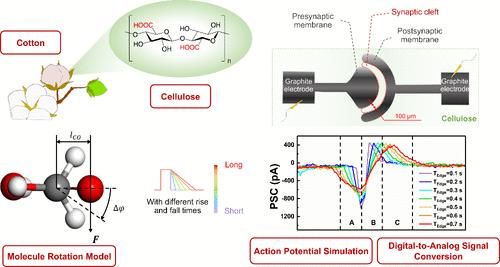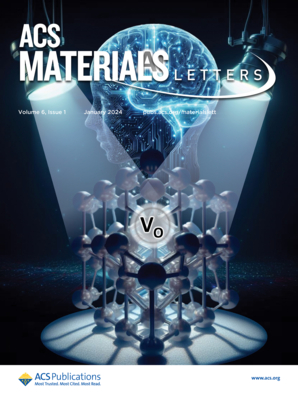Efficient Synaptic Emulation and Ultralow Power Digital-Analog Conversion in Cellulose-Based Neural Devices through Molecular Polarization
IF 9.6
1区 化学
Q1 MATERIALS SCIENCE, MULTIDISCIPLINARY
引用次数: 0
Abstract
Efficient hardware–cell communication is crucial in understanding cellular states and controlling cells, serving as a crucial pathway in advancing next-generation human–machine interfaces. Here, we propose an energy-efficient neural device based on natural cellulose, addressing limitations in conventional interface communication hardware, particularly concerning material biocompatibility and biological signal matching. The cellulose-based device effectively emulates the plasticity of biological synaptic connections and exhibits learning behavior under biograde voltage as low as 10 mV. Significantly, it demonstrates exceptional digital-to-analog conversion performance with a minimal power consumption of 0.1 nJ, facilitating efficient interface biological signal matching. Furthermore, a molecular-level model is introduced to elucidate the rotation of intramolecular polar bonds in cellulose induced by electrical stimulation. This rotation alters the material’s relative dielectric constant, unveiling the digital-to-analog conversion ability and neuro-like behavior. The biocompatible cellulose-based device efficiently emulates synapses with its low-power signal conversion, holding promise for effective biological signal matching in brain–machine interfaces.

通过分子极化实现纤维素神经器件中的高效突触模拟和超低功耗数模转换
高效的硬件-细胞通信是了解细胞状态和控制细胞的关键,也是推进下一代人机界面的重要途径。在这里,我们提出了一种基于天然纤维素的高能效神经设备,解决了传统接口通信硬件的局限性,尤其是材料的生物兼容性和生物信号匹配问题。这种基于纤维素的设备能有效模拟生物突触连接的可塑性,并在低至 10 mV 的生物级电压下表现出学习行为。值得注意的是,该器件具有出色的数模转换性能,功耗仅为 0.1 nJ,有助于实现高效的界面生物信号匹配。此外,还引入了一个分子级模型,以阐明电刺激引起的纤维素分子内极性键旋转。这种旋转改变了材料的相对介电常数,从而揭示了数模转换能力和类似神经的行为。这种基于纤维素的装置具有生物兼容性,可通过低功耗信号转换有效模拟突触,有望在脑机接口中实现有效的生物信号匹配。
本文章由计算机程序翻译,如有差异,请以英文原文为准。
求助全文
约1分钟内获得全文
求助全文
来源期刊

ACS Materials Letters
MATERIALS SCIENCE, MULTIDISCIPLINARY-
CiteScore
14.60
自引率
3.50%
发文量
261
期刊介绍:
ACS Materials Letters is a journal that publishes high-quality and urgent papers at the forefront of fundamental and applied research in the field of materials science. It aims to bridge the gap between materials and other disciplines such as chemistry, engineering, and biology. The journal encourages multidisciplinary and innovative research that addresses global challenges. Papers submitted to ACS Materials Letters should clearly demonstrate the need for rapid disclosure of key results. The journal is interested in various areas including the design, synthesis, characterization, and evaluation of emerging materials, understanding the relationships between structure, property, and performance, as well as developing materials for applications in energy, environment, biomedical, electronics, and catalysis. The journal has a 2-year impact factor of 11.4 and is dedicated to publishing transformative materials research with fast processing times. The editors and staff of ACS Materials Letters actively participate in major scientific conferences and engage closely with readers and authors. The journal also maintains an active presence on social media to provide authors with greater visibility.
 求助内容:
求助内容: 应助结果提醒方式:
应助结果提醒方式:


